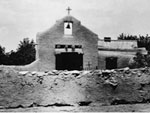Texas and Mexico: Centers for Cultural Collision
Question

What was the impact of American migration to Texas and parts of Mexico on Mexican American relations in the mid-19th century?
Answer
Anglo (meaning non-Hispanic white) migration to Texas began in earnest after Mexico secured its independence from Spain in 1821. In the new republic, Texas was just one part of the state of Coahuila-Texas, a region in Mexico's northern borderlands in which Native communities were powerful. Mexican families lived throughout the northern portion of Coahuila-Texas—the wealthiest of whom were known as Tejanos—and to the Comanche and Lipan Apache they were unwelcome. Viewed from the perspective of the region's Native communities, both Tejano and Anglo settlers were undocumented immigrants.
Many of the first Anglo immigrants to Texas were squatters, individuals who had no Mexican legal claim to their land. By 1824, however, both Mexican and Tejano officials welcomed Anglo settlers, although for very different reasons. The Mexican government wanted assistance securing the country's northern border against raids by the Comanche and other Native groups; the Tejanos wanted help in raising Texas to the level of Mexican statehood, independent of Coahuila, so that they might govern themselves more effectively. Anglo settlers wanted land, and they were initially willing to accept multiple conditions on their immigration in order to get it. In 1825, Mexico passed the Coahuila-Texas colonization law, which offered men at the head of households 177 acres of farming land, grazing rights, and tax breaks in order to settle the region. In return, settlers had to agree to become Mexican citizens, to practice Catholicism, and to uphold all Mexican laws, including those that prohibited slavery.
The vision of colonization held by Mexican officials was soon upended. By the mid 1820s there were more Anglo settlers in Texas than Tejanos, and Anglo families refused to settle where Mexican officials preferred them to go. Instead, they clustered around the state's eastern borders, which made the Mexican government nervous—it appeared that the United States' borders were encroaching into Mexican territory by default.
The Mexican government had good reason to worry. Not only were Anglos more culturally and politically allied with the United States than Mexico—especially on the subject of slavery—but Tejanos initially allied themselves with leading American settlers like Stephen Austin, believing this would position them to gain sovereignty. Mexico's worries were further compounded by the United States offering $1 million for Texas in 1827, and $5 million in 1829. On both occasions, Mexico declined.
By 1832, more than 6,000 Anglo settlers, who owned more than 1,000 slaves, lived in Texas. This compared with 3,000 Tejanos. Some relationships between Tejano families and Anglos became strained when settlers refused to recognize Tejano land rights and forced families from their farms. Many wealthy Tejanos still felt their interests were best served by alliance with Anglo leaders, however, and it was their cooperation that helped make Texan independence possible in 1835. Tejanos fought alongside Anglos in the ensuing war with Mexico, but in the face of a wave of new immigration after Texas declared itself independent of any larger nation, their political and cultural influence in the region declined. Most new Anglo settlers believed that their culture was superior to that of Tejanos and Mexicans alike, and racial prejudice was rife.
The Mexican government never recognized Texas as an independent state. When the United States annexed Texas in 1845 Mexico once again went to war. After three years, the peace Treaty of Guadalupe Hildalgo saw the transfer of millions of acres of Mexican territory to the United States government—modern-day Texas, Arizona, New Mexico, and California, as well as portions of states further north. Anglo settlement, which had once seemed a sound strategic defense against borderland warfare with Indian people, proved the thin edge of a wedge that saw Mexico lose more than half of its territory to the United States.
The Comanche and Lipan Apache continued to defend their territory against immigrants for many more years.
For more information
- The Texas Slavery Project
- "Stephen F. Austin" at the Texas State Library and Archives Commission.
- 1839 Map of Mexico and the United States from the Perry-Castañeda Library Map Collection, University of Texas at Austin.
- Daguerrotypes of Mexican civilians at PBS's The U.S.-Mexican War.
Bibliography
- Chasteen, John Charles. Born in Blood and Fire: A Concise History of Latin America. 3rd ed. New York: W. W. Norton & Co., 2011.
- Kirkwood, Burton. The History of Mexico. Westport, CT: Greenwood Press, 2000.
- Vargas, Zaragosa. Crucible of Struggle: A History of Mexican Americans from Colonial Times to the Present Era. New York: Oxford University Press, 2011.
